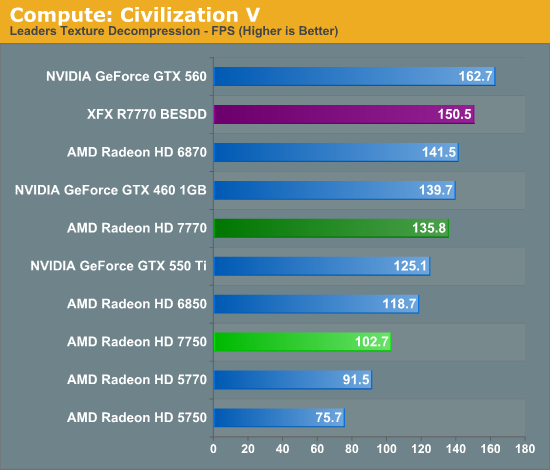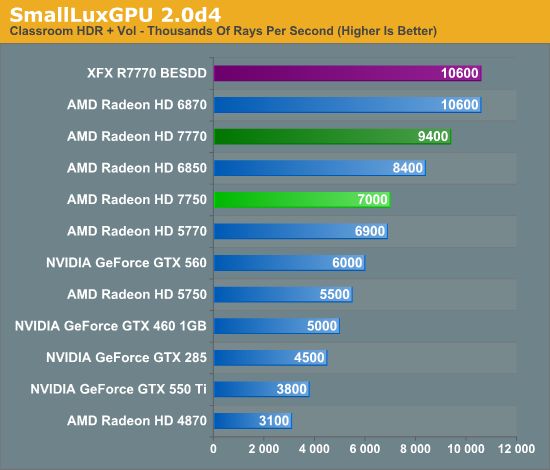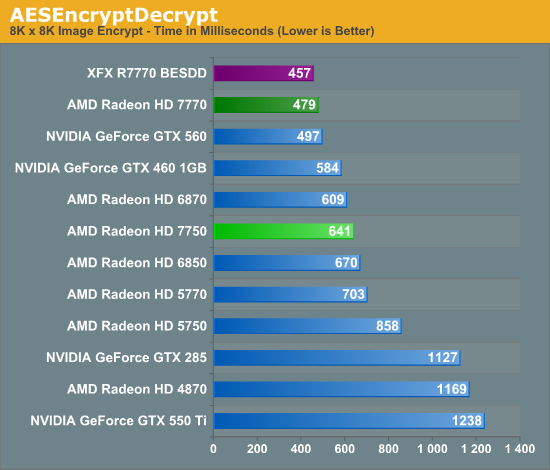AMD Radeon HD 7750 & Radeon HD 7770 GHz Edition Review: Evading The Price/Performance Curve
by Ryan Smith & Ganesh T S on February 15, 2012 12:01 AM EST- Posted in
- GPUs
- AMD
- HTPC
- GCN
- Radeon HD 7000
Compute Performance
Moving on from our look at gaming performance, we have our customary look at compute performance. With GCN AMD significantly overhauled their architecture in order to improve compute performance, as their long-run initiatives rely on GPU compute performance becoming far more important than it is today.
With such a move however AMD has to solve the chicken and the egg problem on their own, in this case by improving compute performance before there are really a large variety of applications ready to take advantage of it. As we’ll see AMD has certainly achieved that goal, but it raises the question of what was the tradeoff for that? We have some evidence that GCN is more efficient than VLIW5 on a per-shader basis even in games, but at the same time we can’t forget that AMD has gone from 800 SPs to 640 SPs in the move from Juniper to Cape Verde, in spite of a full node jump in fabrication technology. In the long run AMD will be better off, but I suspect we’re looking at that tradeoff today with the 7700 series.
Our first compute benchmark comes from Civilization V, which uses DirectCompute to decompress textures on the fly. Civ V includes a sub-benchmark that exclusively tests the speed of their texture decompression algorithm by repeatedly decompressing the textures required for one of the game’s leader scenes. Note that this is a DX11 DirectCompute benchmark.

Theoretically the 5770 has a 5% compute performance advantage over the 7770. In practice the 5770 doesn’t stand a chance. Even the much, much slower 7750 is ahead by 12%, meanwhile the 7770 is in a class of its own, competing with the likes of the 6870. The 7770 series still trails the GTX 560 to some degree, but once again we’re looking at the proof of just how much the GCN architecture has improved AMD’s compute performance.
Our next benchmark is SmallLuxGPU, the GPU ray tracing branch of the open source LuxRender renderer. We’re now using a development build from the version 2.0 branch, and we’ve moved on to a more complex scene that hopefully will provide a greater challenge to our GPUs.

SmallLuxGPU is another good showing for the GCN based 7700 series, with the 7770 once again moving well up the charts. This time it’s between the 6850 and 6870, and well, well ahead of the GTX 560 or any other NVIDIA video cards. Throwing in an overclock pushes things even farther, leading to the XFX BESDD tying the 6870 in this benchmark.
For our next benchmark we’re looking at AESEncryptDecrypt, an OpenCL AES encryption routine that AES encrypts/decrypts an 8K x 8K pixel square image file. The results of this benchmark are the average time to encrypt the image over a number of iterations of the AES cypher.

Under our AESEncryptDecrypt benchmark the 7770 does even better yet, this time taking the #2 spot and only losing to its overclocked self. PCIe 3.0 helps here, but as we’ve seen with the 7900 series there’s no replacement for a good compute architecture.
Finally, our last benchmark is once again looking at compute shader performance, this time through the Fluid simulation sample in the DirectX SDK. This program simulates the motion and interactions of a 16k particle fluid using a compute shader, with a choice of several different algorithms. In this case we’re using an (O)n^2 nearest neighbor method that is optimized by using shared memory to cache data.

It would appear we’ve saved the best for last, as in our fluid simulation benchmark the top three cards are all 7700 series cards. This benchmark strongly favors a well organized cache, leading to the 7700 series blowing past the 6800 series and never looking back. Even NVIDIA’s Fermi based video cards can’t keep up.










155 Comments
View All Comments
Dug - Wednesday, February 15, 2012 - link
For the cost of one game you could just get the nvidia 560. In fact you could of gotten it a long time ago and still be way ahead.beginner99 - Wednesday, February 15, 2012 - link
Well seeing this makes me feel a little less bad on how much a paid for my 5850 1.75 years ago. Absolutely 0 reason to upgrade...However now it seems AMD GPU division is starting to blunder too...
solarTermination - Wednesday, February 15, 2012 - link
I really don't understand what AMD is thinking here. The 7770 is preposterous at this performance/price level, and it boggles the mind that they designed it this way. I'm really stumped here, it's like they're spitting in all of our faces to release a card that has less performance and costs more than a widely available 2 year old part.They must take us for fools. Nothing else could explain this. Technology is supposed to improve as the years go by, not tread water, and certainly not get worse. You see this kind of bs and the revolving door of talent at AMD starts to make more sense. There must be some real pieces of work running that place.
I think it's finally time to join them. Nvidia, here i come.
CeriseCogburn - Saturday, March 10, 2012 - link
It's obvious isn't it ? They are a collapsing wreck that have culled with the ax their dwindling workforce as they've sold off assets to leave them with nothing but ip.Now after striking away Bain Capital style at the failing red bottom line - in the deep debt for endless years under the tightwad whining fan base and OCD focused complaint review sites meshing pennies and fps to an insane nuovo art form that should embarrass it's fans rather than fill them with false self esteem and self congratulating "I'm brilliant" mirror apprasials, they must further the save their life goal and actually ask their tenderly coddled and deceived rabid fan base to cough up some survival dollars...
Unfortunately, the years of low price bragging filled with lies albeit effectiveness as an ignorant fool lives in bliss, has come to backfire on them at the worst time possible, the end of the line.
As Mr. Smith said, it was inevitable.
Now amd needs a hero to save it's collapse and absorption into the wider market matrix.
shin0bi272 - Wednesday, February 15, 2012 - link
I have a gts250 and I get about the same fps as the 7750. I paid just over 100 bucks (109 IIRC) for it and its almost 3 years old and keeps up with these brand new cards. I cant decide if that's funny or sad.Menoetios - Wednesday, February 15, 2012 - link
While these cards definitely deserve flak for their starting prices, I'm not nearly as disappointed overall as many here seem to be. I have no doubt that their prices will come down in time. Consider that the 7750 is the absolute slowest GCN card. I fully expect to see a tastey sub-$90 price for the 7750s by the time Nvidia gets their 28nm line out. The 28nm process is still extremely supply constrained; it wouldn't make sense to price the cards out any lower to increase sales when there simply aren't any to sell. Whether Kepler trounces GCN or equals it, its introduction will be when the real shift in the price/performance shift occurs, both from competitive pricing as well as the 28nm ramp up.kmmatney - Wednesday, February 15, 2012 - link
Well, I'm glad I was able to pickup an HD6850 for $139 shipped (no rebates). I can see why the 7750 would be great for notebooks, but I don't see much point in this card for the desktop.CknSalad - Wednesday, February 15, 2012 - link
I think it's safe to say that ever since the release of bulldozer, AMD has been hit hard financially. They spent a lot of R&D and probably put all their eggs in one basket in that project. As much as their efforts can be admired, it seems that this has taken so much of AMD R&D money that now they don't have much to offer for even their gpu lineup.I understand that there is little competition and that this is the 'first gen' of 28nm cards, but there should seriously be at least 10-15% performance boost for the whole lineup. Going from 40nm to a 28nm process is a big jump. The 'there is little competition' so these cards are priced this way is still unacceptable. I'm starting to be wary of the 7800 series cards as I'm looking forward to buying a card no more than the low $300 range.
Hopefully Nvidia has something up their sleeves and can give us true 28nm performance we should be seeing. I am in no way an nvidia fanboy as I have had both ati and nvidia cards. The only thing i worry for nvidia's kepler cards is the power consumption. However, if the performance gain more than makes up for the minor increases in power consumption, then it will be more than worth it.
Sttm - Wednesday, February 15, 2012 - link
Yes they are price gouging for the next 3 months because they can. Also the 7700 series is complete shit performance wise and will only find its home in the hands of the uninformed and the low power systems built by Dell and HP.Nvidia is the only hope of seeing a good price/performance boost now.
Sttm - Wednesday, February 15, 2012 - link
"and at that point, this card at 159$ would make sense."No it wouldn't actually, since with the move to 28nm you should be seeing a performance increase per dollar not the same. The performance of a 6850 should be around $79 this generation, with the $160 cards offering almost 6950/560ti level of performance.
This is what Nvidia will most probably be offering with their next gen parts, and what AMD will have to lower their costs to if they expect anyone outside of the fanboys to but them.